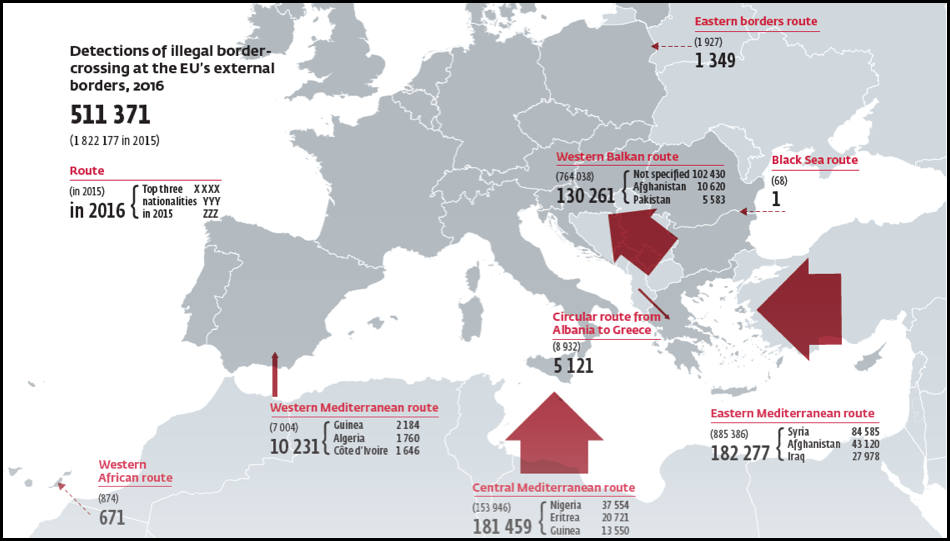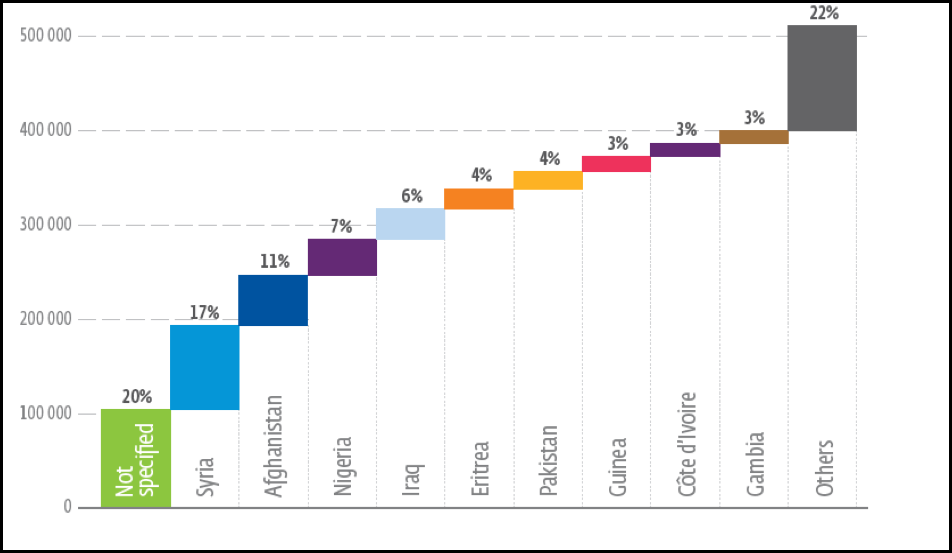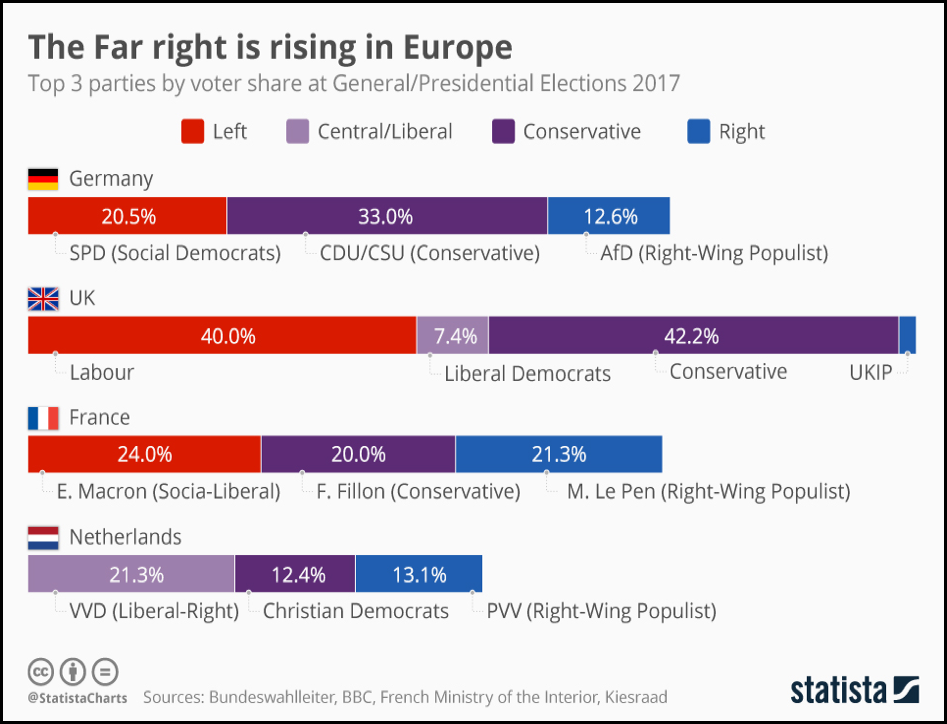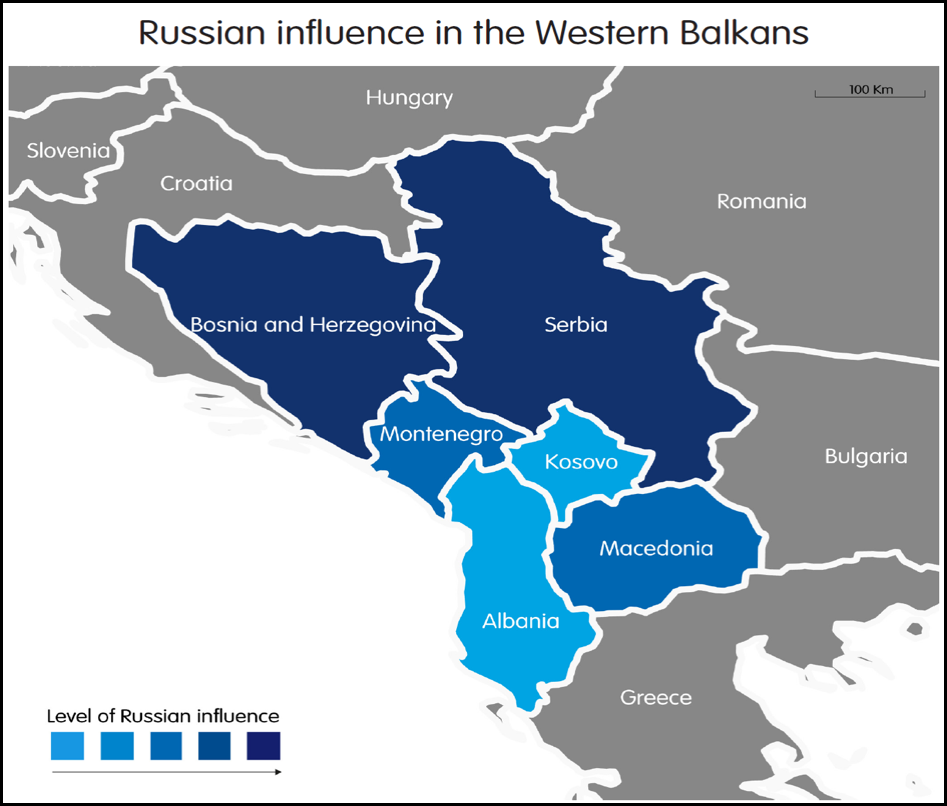For a decade now, documented migrants along with undocumented migration has become one of the main concerns that is dominating the headlines of European media and setting the agenda of both the European Union (EU) and the member states. Many images and videos exist of the plight including: thousands of migrants walking towards Europe through the Balkans, migrants living in misery in the makeshift tent cities on the borders, migrants stuck in small boats struggling to survive in the dangerous waters of the Mediterranean, or the dead bodies of babies washed ashore. However, these images are just the tip of the iceberg. There are many others who enter the ‘Fortress Europe’ by official documents and continue to stay even after their allowed date by law expires. Several others use counterfeit passports and visas and even work in the country legally with forged ID cards and work permits (Sheryazdanova, 2015, p.89). The EU and member states have long been struggling but unable to restrain the situation despite strong preventive measures. These uncontrollable images of undocumented migrants on the news are making the situation more complicated as European populations, who have enjoyed peace, prosperity and welfare environment since the last world war, are wavering between fear, anxiety and the humanitarian values of the European democracy.
History of Undocumented Migration in the Europe
Europe has long been familiar with the term migration as Europe itself was the main migrant exporter to the other parts of the world during the 19th century and the early years of the 20th century. During those years, migration was seen as an opportunity by Europeans (Wohlfeld, 2014, p.62). When World War II ended, migration appeared as the sole remedy to meet the labor force to erect war-torn Europe and the migrants doing undesired jobs under hard conditions were very welcomed. Throughout time, the number of migrants in Europe has grown exponentially and reached 10.9 million in 1970 and 16 million in 1990 (See Table-1) (Bade, 2004, p.340). “The end of the Cold War marked the beginning of a new era for migration as well as for migration politics in Europe” (Bade, 2004, p.339). EU policies were shaped by the fear that a new flow of undocumented migrants from the east (the “Iron Curtain” countries) would add to the already significant flow of migrants coming from the south. Undocumented migration began to be perceived as a security threat to the whole continent (Bade, 2004, p.340).

Table-1: Foreign Resident Population in Western European States 1950-2000 Source: Bade, K. J., 2004. “Legal and Undocumented migration into Europe: Experiences and Challenges”
The adoption of the Plan of Tampere in 1999 was an important step to harmonize the efforts against undocumented migration within the EU and between member states. With the Tampere plan, the European Council was calling for more cooperation and mutual assistance between the member states, especially on border control and information and technology sharing issues (European Parliament). The establishment of the European Agency for the Management of Operational Cooperation at the External Borders of the Member States of the European Union (FRONTEX) in 2004 was a concrete step showing the determination of the EU to secure the external borders. It was replaced by the European Border and Coast Guard Agency (also FRONTEX) in 2016. Throughout history, several agreements were adopted to enhance cooperation both within the EU and also between the EU and third parties in order to fight against undocumented migration (Sheryazdanova, 2015).
However, following the Arab Spring in 2011, huge flows of internally displaced people in the Levant and North Africa were major clues of a forthcoming migration flow towards Europe. According to the numbers released by the FRONTEX Risk Analysis for 2017, the EU borders are still under intense migratory pressure. The number of detections in 2016 declared was 511,371, which was far beyond the estimations compared to the 104,060 detections in 2010 and the 282,933 in 2014 (Figure-1).

Figure-1: Detections of Undocumented or “Irregular” Border-crossings at the EU’s External Borders. Source: FRONTEX Risk Analysis for 2017. http://frontex.europa.eu/assets/Publications/Risk_Analysis/Annual_Risk_Analysis_2017.pdf
In terms of nationalities, Syrians comprised 17% of this total number. Afghans followed as second most with 11% while Iraqis represented the third most with 6% of all detections in 2016 (Figure-2).

Figure-2: Detections of Undocumented border-crossing, by main nationalities Source: FRONTEX Risk Analysis for 2017.
Despite a great effort which included the allocation of personnel and an increased budget, recent immigration flows have demonstrated that the EU couldn’t handle the vast incoming migration and that there is still a long way to go to contain or solve the issue.
Does Undocumented Migration pose a threat for European security?
There is an ongoing discussion between scholars whether this migration poses a threat to the national security of the countries of destination or if the migrants themselves are the ones in danger considering their long and dangerous journey to their destination (Wohlfeld, 2014, p.68). Based on historical trends and the current situation, it can easily be inferred that the EU considers undocumented migration as a threat to the ‘Fortress Europe’. However, one must wonder how these ordinary men, women and children, who have risked death for a chance for a better life, can be considered as a threat to national security?
Scholars believe that there are several aspects of national security. Protecting the nation against any armed intervention is the primary duty of the state. In the Westphalian world order, any kind of undocumented or “irregular” trespassing of the national borders is perceived as a threat to the national sovereignty. Therefore, the current flow of undocumented migration, if not controlled, would threaten the sovereignty of both the member states and the EU.
Besides undocumented border trespassers, there are many others trying to enter the EU by using official means of entry such as fraudulent passports, visas and identity cards. According to FRONTEX, in 2016 more than 7,000 people were detected while using fraud documents at the airports, seaports and border control points. “Fraudulent documents allow irregular migrants to enter and move within the EU as well as to regularize their residence status under false pretenses or by using fake identities.” (FRONTEX, 2017, 22). Human traffickers have long been providing fraudulent documents to migrants in exchange for money. As the numbers of undocumented migrants increases, this profitable business line is attracting more criminal groups every day. The increase in the numbers of criminal groups has posed a threat to law and order, as they benefit not only from the human trafficking but also from other means of trafficking such as weapons, drugs and stolen goods (Koser, 2011, p.2).
People’s attitude against migrants began to largely changed since the 9/11 attacks in the United States. Recent terrorist attacks by the Islamic State terrorist group in Belgium, France and Germany have already intensified this prejudice against undocumented migrants as many believe that terrorists are entering Europe by disguising themselves as migrants. Although there is no proven link between the two, “Real or imagined links to terrorism, organized crime … threats are at the core of the perception of irregular migration as a security threat.” (Wohlfeld, 2014, p.68). This perception paves the way for nationalist or extremist ideas to strengthen, which mostly benefits extreme right-wing parties. Nowadays, rising nationalism is threatening democracies of the Europe. The triumph of Trump, whose campaign rhetoric was mainly targeting the immigrants in the U.S., has inspired the right-wing candidates of the Europe (Pazzanese, 2017). Alternative für Deutschland (AfD), which has recently entered the German parliament as the third-largest party, is the latest example of the rising nationalism in the Europe. Marine Le Pen and her Front National in France and Geert Wilders and his Freedom party (PVV) in the Netherlands are also on the rise (Figure-3), and needless to say, Hungary and Poland have already been run by authoritarian populists (Joffe, 2017).

Figure-3: The Far Right is Rising in Europe. Source: Statista. https://www.statista.com/chart/11228/far-right-gaining-ground-in-europe/
During peacetime, protecting and promoting the welfare of the citizens appears as one of the most important duties of the governments. Any kind of influx that threatens the social and economic fabric of the society can be perceived as a threat by ordinary citizens. In 2016, the number of detected undocumented stayers in Europe was reported as 491,891; however, the real number (including those who were not detected) should be expected to be more (FRONTEX, 2017, p.25). They cannot be tracked by the state, since they are not registered in the system of employment, tax, and social security. As they have to earn for their livelihood, they appear as the main candidates for the shadow economy which usually has a negative effect on the wage and unemployment levels of the autochthonous population (European Migration Network, 2006, p.8). When it comes to social life, “[t]hey are also different: they bring new lifestyles and languages, traditions and values. Throughout human history, the outsider, the ‘other’, has been the focus of suspicion and often hatred (The International Council on Human Rights Policy, 2010, p.2). As Sheryazdanova mentions, these kinds of social differences and economic competition, if not tolerated, involves the risk of creating xenophobia and radical nationalism (2015, p.90). On the other hand, the situation is like a double-edge sword. Rising xenophobia, which is currently in the form of Islamophobia in Europe, has the potential of aggravating the radicalization among immigrants which makes them become the target audience and recruiting source of extremist terrorist organizations.
Additionally, undocumented migration-related problems on the borders have been posing a threat to the solidarity and the unity of the EU. According to Dublin regulations, migrants should apply for asylum in the first entry point to Europe. However, this brings a heavy burden to the bordering states such as Greece, Italy, Spain and Hungary. Despite the recent burden sharing agreements, these countries still bear the largest share of the overall challenge of undocumented migration as migrants continue to flow to Europe via these countries. Every member state is developing different practices to curb the problem. Many Non-Governmental Organizations are accusing the member states, such as Italy, Greece and Hungary, of violating laws relating to basic human rights in regards to the migrants (Cierco and Silva, 2016, 7).
Lastly, with the 2015 refugee crisis, the EU’s position weakened in the Balkans. “The EU has become a net exporter of instability” (Lasheras, Tcherneva and Wesslau, 2016) to the Balkans. Some refugees who enter Europe are stuck going to non-EU countries as countries like Hungary and other member states closed their borders. Russia benefitted from the increasing tension between parties by expanding its area of influence (Figure-4) and signed a strategic partnership agreement with Serbia (Lasheras, Tcherneva and Wesslau, 2016).

Figure-4: Russian Influence in the Western Balkans. Source: Lasheras, F.B., Tcherneva V., and Wesslau F., 2016. “Return to Instability: How Migration and Great Power Politics Threaten the Western Balkans”, ECFR/163 March 2016 www.ecfr.eu
Strategies to Mitigate the Impact of Undocumented Migration
The adoption of the Plan of Tampere in 1999 and The Hague Program in 2004 were two concrete steps to harmonize the efforts within the EU in the fight against undocumented migration. In 2005 the EU established the European Agency for the Management of Operational Cooperation at the External Borders- FRONTEX- which was a sign of determination for protecting the external borders of the EU against undocumented trespassing. It was understood that establishing common practices within the EU is important but not enough, unless third parties are included. The European Pact on Immigration and Asylum, signed in 2008, offered a more comprehensive plan which enhanced measures taken against migration, by including cooperation with third parties.
However, the heavy burden of Arab Spring in 2011 and later the Syrian civil war have put pressure on the EU. In search of a more flexible approaches, Dublin and Schengen regulations were rearranged to enable burden-sharing among members. However, the uncontrollable migrant flow from the Balkans in 2016 rendered the EU helpless until an agreement was signed with Turkey. It was announced as a decisive solution to the problem, but in reality, it just helped the EU gain some time until the next migrant flow from a different location. It was also the first time that NATO, in cooperation with Frontex, patrolled to prevent human traffickers moving in the Aegean Sea. This might be a starting point for broader and more comprehensive cooperation among international actors.
Later on, in 2017, like with Turkey, a similar agreement was signed with one of three governments of Libya with the hope of closing the Southern route (Toaldo, 2017, p.1). Signing an agreement with countries that are located on the transit migration routes is a short-term solution as human traffickers will just begin to look for different, open routes. However, a long-term solution would be cooperation with the countries of origin of these migrants, as it would address the root of the issue.
Conclusion
Throughout human history, People have migrated for several different reasons such as droughts, illnesses, disasters, wars, and many more. Despite passing time and changing world order, people still move to different locations in search of a better life. There is a well-known fact that nobody could stop a person who has nothing to lose. Taking this fact into account, one should understand that it is impossible to stop migration, instead, those in power should think about how to manage it.
References:
Bade, K. J., 2004. “Legal and Undocumented migration into Europe: Experiences and Challenges”, European Review, Vol. 12, No. 3, 339–375 (2004) © Academia Europaea, Printed in the United Kingdom.
Cierco, T. and Silva, J.T., 2016. “The European Union and the Member States: Two Different Perceptions of Border”, Rev. Bras. Polít. Int., 59(1): e003.
European Migration Network, 2006. “Impact of Immigration on Europe’s Societies”.
European Parliament, “Tampere European Council 15 and 16 October 1999 Presidency Conclusions”. http://www.europarl.europa.eu/summits/tam_en.htm
Frontex Risk Analysis for 2017. http://frontex.europa.eu/assets/Publications/Risk_Analysis/Annual_Risk_Analysis_2017.pdf
Joffe, J., September 29, 2017. “The right is rising and social democracy is dying across Europe – but why?” The Guardian. https://www.theguardian.com/commentisfree/2017/sep/29/right-social-democracy-dying-europe-afd-far-right-germany
Koser, H., 2011. “When is Migration a Security Issue?”, Brookings. https://www.brookings.edu/opinions/when-is-migration-a-security-issue/
Lasheras, F.B., Tcherneva V., and Wesslau F., 2016. “Return to Instability: How Migration and Great Power Politics Threaten the Western Balkans”, ECFR/163 March 2016 www.ecfr.eu
Pazzanese, C., February 27, 2017. “In Europe, Nationalism Rising”, Harvard Gazette. https://news.harvard.edu/gazette/story/2017/02/in-europe-nationalisms-rising/
Sheryazdanova, K., 2015. “Undocumented migration and Fight against Illegal Migration in Member States of the European Union”, Acta Univ. Sapientiae, European and Regional Studies, 8 (2015) 89–102.
The International Council on Human Rights Policy, 2010. “Irregular Migration, Migrant Smuggling and Human Rights: Towards Coherence”, Geneva, Switzerland.
Toaldo, M., 2017. “The EU deal with Libya on migration: a question of fairness and effectiveness”, European Council on Foreign Relations.
Wiese, T., September 25, 2017. “The Far-Right is gaining ground in Europe”, Statista. https://www.statista.com/chart/11228/far-right-gaining-ground-in-europe/
Wohlfeld, M., 2014. “Is Migration a Security Issue?”, in Omar Grech and Monika Wohlfeld (eds), Migration in the Mediterranean: Human Rights, Security and Development Perspectives. MEDAC: Malta, 2014.
http://www.um.edu.mt/medac/publications/book_publications/migration_in_the_mediterranean

